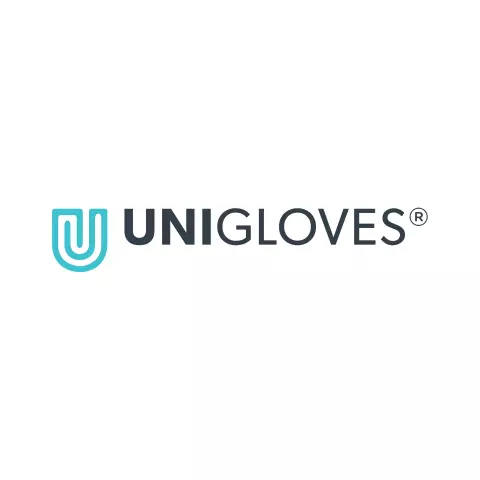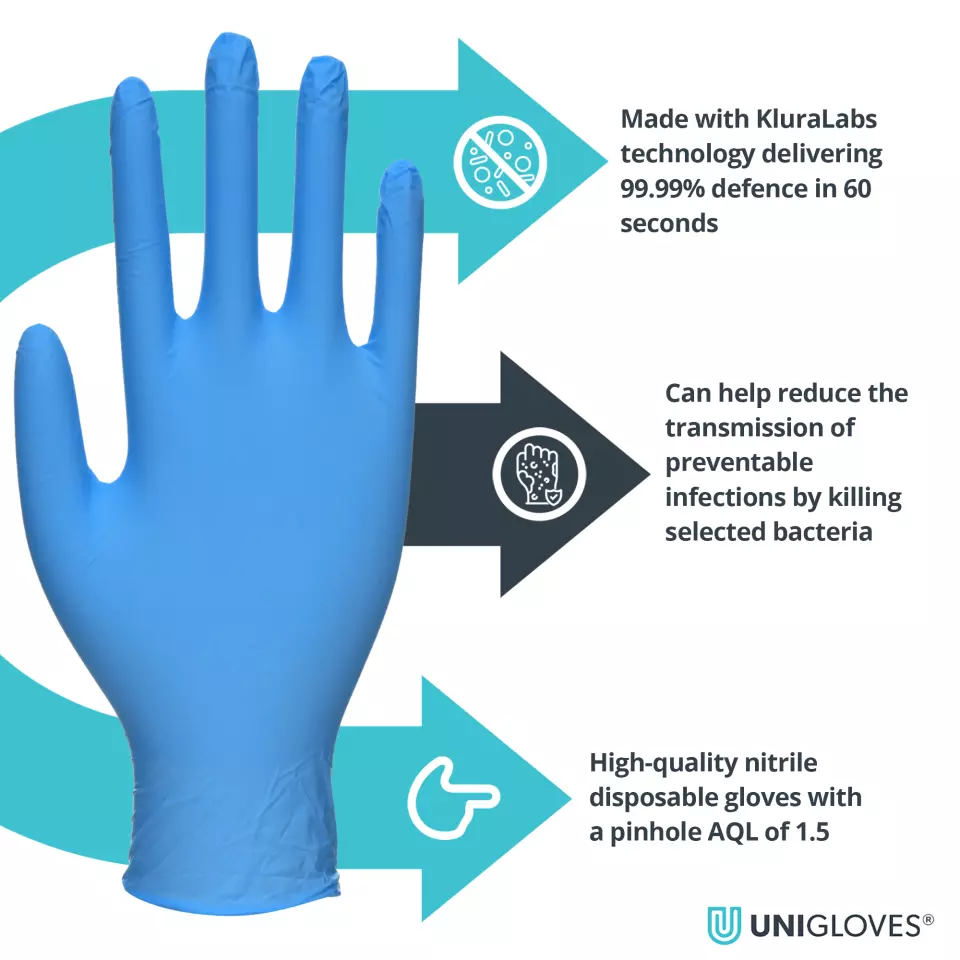Unigloves Cross Guard Antimicrobial Nitrile Glove
Unigloves
visit storeProduct description
Eliminates 99.99% of selected bacteria in 60 seconds
Can help reduce the transmission of preventable infections by killing harmful bacteria
Class 1 Medical Device in Europe
Third party ASTM Efficacy Validation
Effective against Healthcare Acquired Infections
No active ingredients and non leaching
Suitable for contact with all food types
Describes whether fingertips have a smooth or textured surface, affecting grip strength, tactile sensitivity, and handling precision for various applications.
Crafted without phthalates, these gloves offer a worry-free option. Ideal for users seeking to minimize exposure to specific chemical plasticizers.
Designed for use on either hand, these gloves offer convenience and efficiency. Their symmetrical design simplifies donning and reduces waste.
Offers complete hand coverage, ensuring hygiene and protection. Ideal for various tasks requiring a barrier against contamination and maintaining cleanliness.
Crafted without natural rubber latex, these gloves are ideal for sensitive skin. Provides a comfortable fit for those with latex sensitivities.
Offers versatile hand protection for various tasks. Balances durability and flexibility, suitable for diverse applications requiring barrier protection.
Enables seamless use of touch screen devices without removing gloves. Maintains hygiene and protection while using phones or tablets.
Indicates whether gloves contain donning powder. Powder-free options reduce allergen risks and contamination, while powdered versions offer easier application.
Refers to whether gloves have a smooth or textured finish, affecting grip strength, dexterity, and handling ability in wet or dry conditions.
Indicates the glove's pigmentation, which can aid in color-coding tasks, enhancing visibility, or meeting specific industry requirements for contamination control.
Indicates the composition of the gloves, affecting properties like elasticity, chemical resistance, allergen potential, and suitability for specific tasks.
Measures the material thickness in the finger areas, balancing protection against punctures and chemicals with tactile sensitivity for precision tasks.
Measures from fingertip to cuff end, determining wrist/forearm coverage. Longer gloves provide enhanced protection against splashes and contaminants.
Measurement of material thickness in the palm area, affecting protection level, durability, and dexterity. Critical for matching gloves to specific tasks.
Indicates the statistical quality inspection standard measuring defect rates. Lower AQL values (e.g., 0.65) signify fewer defects and higher protection reliability.
Indicates how long gloves maintain their protective properties when properly stored. Longer shelf life ensures reliability and helps optimize inventory management.
- Chemical Resistance
- Hand Protection
Request a free sample
Test first and buy later. Visit any product page to request your free sample.
Standards and labels
EN ISO 374-1:2016 is a standard that defines the performance requirements for gloves that protect against chemicals and microorganisms. The standard specifies the design, materials, and testing requirements for gloves to protect against chemicals and microorganisms. Possible test results include measurements of the gloves' permeation resistance, degradation, and penetration. It also includes the safety and functionality requirements for gloves.
Test results
Specified Requirements Type CEN 374-4:2013 is a European standard for gloves that protect against microorganisms. It sets rules for how the gloves should protect against microorganisms and how to test if they meet the standards. Gloves that pass the tests can have a label that says they meet the standard. The test results can be pass or fail for each test that checks the gloves resistance to microorganisms.
Test results
Degradation TestedThe standard EN 374-4:2013 pertains to the determination of degradation by chemicals for protective gloves. Degradation is assessed based on the change in physical properties of the glove material after contact with a chemical. Specifically, a result indicating degradation provides a measure of the glove's deterioration in terms of features like tensile strength and elongation when exposed to specific chemicals, gauged through physical tests such as elongation and tensile tests. The test method involves exposing the glove material to the chemical over a determined period, followed by mechanical testing to compare the pre and post-exposure properties. This result is crucial in determining the glove's suitability for use with specific chemicals, as degradation can significantly reduce its protective effectiveness, potentially endangering the user. Hence, understanding and adhering to this standard helps in the selection of appropriate protective gloves for specific chemical exposure scenarios, ensuring user safety and compliance with health and safety regulations.
EN 374-5:2016 is a European standard for gloves that protect against microorganisms, specifically gloves that are used for medical and dental procedures. It sets rules for how the gloves should protect against microorganisms and how to test if they meet the standards. Gloves that pass the tests can have a label that says they meet the standard. The test results can be pass or fail for each test that checks the gloves resistance to microorganisms.
Test results
Micro-organisms VirusEN 374-5:2016 is a standard that outlines the requirements and testing methods for protective gloves designed to protect against viruses. The designation 'Virus' indicates that the gloves have passed specific tests confirming their barrier effectiveness against viruses. These tests involve assessing the glove material's resistance to penetration by blood-borne pathogens and other virus-containing fluids, using a bacteriophage as a surrogate virus due to its small size and resistance. Gloves that meet this standard are vital in healthcare settings, laboratories, and any environment where there is a risk of exposure to viral infections. They are crucial for preventing the transmission of diseases, ensuring that workers are protected when handling potentially infectious materials, thus enhancing safety and health protocols in workplaces with biological hazards.
Micro-organisms Bacteria & FungiEN 374-5:2016 specifies the requirements and test methods for protective gloves intended to protect against bacteria and fungi. The designation 'Bacteria & Fungi' indicates that the gloves have been tested and verified to provide effective barrier protection against microbial agents. The testing involves evaluating the glove's material and seams for their impermeability to microorganisms under conditions that simulate real-world use, ensuring no penetration occurs through the glove material or at the seams. Gloves certified under this standard are crucial for use in environments such as healthcare, laboratory settings, and any applications where preventing the transmission of infectious agents is essential. They help ensure the safety and hygiene of workers by providing reliable protection against the risks of bacterial and fungal contamination.
CE Marking is a label that shows a product meets certain safety and environmental standards set by the European Union. To get the CE Marking, a company must test and certify their product meets these standards. CE Marking is required for many products sold in the EU, including electronics, machinery, toys and medical devices. It helps ensure that products are safe for consumers and the environment, and allows for easy trade within the EU.
Food safe refers to the safety of food products that are used or consumed by people. In Europe, food safety is regulated by the European Union (EU) and the European Food Safety Authority (EFSA). These organizations set standards and requirements for food products to ensure they are safe to eat. To be considered "food safe" in Europe, a product must meet these standards and be free of harmful substances. This includes being free of harmful bacteria, pesticides, and other contaminants. Food products that do not meet these standards cannot be sold or used in the EU.
MD stands for "Medical Device." It refers to any instruments, apparatus, machines, implants, or other similar or related articles that are intended to be used for human beings for the purpose of diagnosis, prevention, monitoring, treatment or alleviation of disease, injury or disability. In Europe, a MD Label is a special label that must be on all Medical Devices that are sold or used in the European Union (EU). The label must include information about the product, such as the name of the manufacturer, the intended use of the product and CE mark. To be able to sell or use a Medical Device in the EU, the device must meet certain standards and requirements set by the European Union and notified body.
Unigloves delivery terms
Free delivery when you order more than 1 650,00 kr from Unigloves
Supplier shipping fee 60,00 kr
Brand minimum 15 000,00 kr
489,14 kr
Price per 10 packages (1 000 pcs)
48,91 kr / 100 pcs
Shipping fee is 60,00 kr for orders under 1 650,00 kr
A carton contains 10 packages (1 000 pieces)
Need larger quantities?
Other products you may like
Recently viewed
Need help?
Get help from our experts
Other products you may like
Similar products you may like
Recommended for you
Unigloves
Delivery time: 5 business days
Orders from 15 000,00 €
Supplier shipping fee 60,00 €
Free shipping on orders over 1 650,00 €



Find +150,000 products from hundreds of brands
Autonomous sourcing platform
The most efficient way to source and order supplies for your operations
Sourcing
Ordering
List products you’re looking for and we’ll find the best products and prices for you – all for free.
Need help?
Get help from our experts


